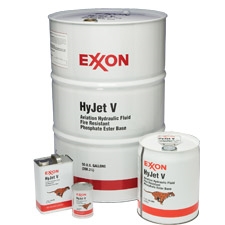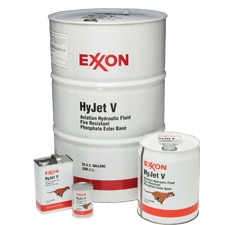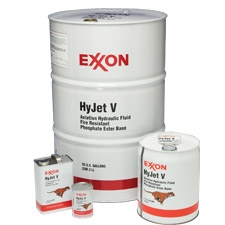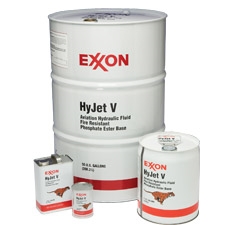SAE AS1241 Exxon HyJet V Hydraulic Fluid-qt
Description
SAE AS1241 Exxon HyJet V Aviation Hydraulic Fluid-qt
Exxon HyJet V is a Type V fire-resistant phosphate ester hydraulic fluid, which is superior in thermal and hydrolytic stability to commercially available Type IV hydraulic fluids.
Better stability means the extent of fluid degradation in aircraft systems will be less than Type IV fluids, in-service fluid life will be longer, and consequently aircraft operator maintenance costs may be lower.
To learn more, download the Exxon hyjet v fact sheet >>
Features & Benefits SAE AS1241 Exxon HyJet V Aviation Hydraulic Fluid-qt
|
HyJet V provides excellent high and low temperature flow properties (kinematic viscosities) and rust protection. HyJet V has also demonstrated an improvement over the erosion protection performance afforded by Type IV fluids. Exxon HyJet V offers the following key features and benefits:
|
Applications of SAE AS1241 Exxon HyJet V Aviation Hydraulic Fluid-qtExxon HyJet V is designed for use in commercial aircraft phosphate ester hydraulic systems. It meets the SAE AS1241 requirements and is included in commercial and business airframe manufacturer Qualified Products Lists, as shown below. It is compatible in all proportions with commercial Type IV and Type V phosphate ester aviation hydraulic fluids. |
Specifications and Approvals of SAE AS1241 Exxon HyJet V Aviation Hydraulic Fluid-qt
| HyJet V | Meets | Is In Qualified Products List |
|---|---|---|
| SAE Aerospace Standard AS1241 Type V | x | Not Applicable |
| Airbus NSA 307110N Type V | x | x |
| Boeing BMS 3-11P Type V, Grade A and Grade C | x | x |
| Boeing-Long Beach DMS 2014H Type 5 | x | x |
| ATR NSA307110N Type V | x | x |
| Gulfstream 1159SCH302J Type V | x | x |
Typical Properties SAE AS1241 Exxon HyJet V Aviation Hydraulic Fluid-qt
| Test Method | HyJet V (1) | Limits | |
|---|---|---|---|
| Kinematic Viscosity, cSt | ASTM D 445 | ||
| at -53.9ºC (-65ºF) | 1350 | 2000 max | |
| at -26.1ºC (-15ºF) | 132 | 135 max | |
| at 37.8ºC (100ºF) | 10.6 | 10.0 – 11.0 | |
| at 98.9ºC (210ºF) | 3.6 | 3.35 – 3.75 | |
| at 127.6ºC (260ºF) | 2.6 | 1.5 min | |
| Viscosity Index | ASTM D 2270 | 280 | |
| Shear Stability, % Viscosity Drop at 40ºC | ASTM D 5621 | 21 | |
| Pour Point, ºC (ºF) | ASTM D 97 | ‹-62 (-80) | -62 (-80) max |
| Specific Gravity at 25ºC/25ºC (77ºF/77ºF) | ASTM D 4052 | 0.997 | 0.991 -1.003 |
| Density at 15.6ºC (60ºF), g/mL (lb/gal) | ASTM D 4052 | 1.000 | (8.35) |
| Acid Number, mg KOH/g | ASTM D 974 | 0.04 | 0.1 max |
| Water, Karl Fischer, mass % | ASTM D 6304 | 0.09 | 0.2 max |
| Flammability | |||
| Flash Point, ºC (ºF) | ASTM D 92 | 174 (346) | 160 (320) min |
| Fire Point, ºC (ºF) | ASTM D 92 | 186 (366) | 177 (350) min |
| Autoignition Point, ºC (ºF) | ASTM D 2155 | ›427 (800) | 400 (752) min |
| Foaming Tendency/Stability, mL foam/sec to collapse | ASTM D 892 | ||
| Sequence I | 32/18 | 250/100 max | |
| Sequence Il | 23/13 | 150/50 max | |
| Sequence Ill | 34/19 | 450/250 max | |
| Particle Count, NAS 1638 Class | Auto Counter | 4 | 7 max |
| Chemical Elements, ppm | |||
| Calcium | 4 | 20 max | |
| Potassium | 38 | 48 max | |
| Chlorine | 10 | 50 max | |
| Sodium | 1 | 15 max | |
| Sulfur | 51 | 200 max | |
| Four-Ball Wear, Scar diameter at 75ºC/600rpm/1hour, mm | Modified ASTM D 4172 | ||
| 4 kg | 0.21 | 0.45 max | |
| 10 kg | 0.26 | 0.50 max | |
| 40 kg | 0.63 | 0.55-0.85 | |
| Electrical Conductivity at 20ºC, microSiemens/cm | 0.4 | 0.3 min | |
| Bulk Modulus, Isothermal secant at 100ºF/3000 psi, psi | 210,000 | ||
| Thermal Conductivity at 40ºC, cal/sec/cm2/ºC (Btu/hr/ft2/ºF) | 33×10^-5 (0.0799) | ||
| Coefficient of Thermal Expansion, 25 to 100ºC, per ºC (per ºF) | 0.00086 (0.00048) | ||
| Specific Heat Capacity at 40 ºC, cal/g/ºC (same as Btu/lb/ºF) | 0.42 |
(1) Values may vary within modest ranges
Additional information
| Weight | 1 lbs |
|---|
You must be logged in to post a review.





Reviews
There are no reviews yet.